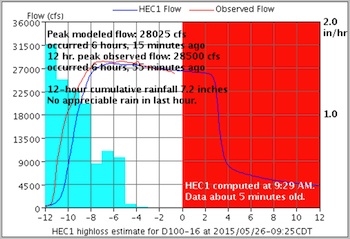
Floodwaters fill State Highway 288 just east of Hermann Park in Houston on May 26. A storm dropped more than 8 inches of rain on the watershed area overnight, causing Brays Bayou to overflow at 288. Upstream near the Texas Medical Center, the bayou stayed within its banks, as predicted by the Rice-designed Flood Alert System. Photo by Brandon Martin
Monitor provides early warning to Texas Medical Center institutions

This Flood Alert System graph tracks the flow of water through Brays Bayou where it passes near Texas Medical Center. The blue line is the predicted flow in cubic feet per second; the red line is the actual flow. The image above shows the predicted vs. actual flow for the May 25-26 storm as of mid-morning May 26th. Click on image for current chart.
The Rice University and Texas Medical Center Flood Alert System 3 performed up to spec and beyond during the storm that deluged Houston May 25 and 26, according to its designer, Phil Bedient. Bedient is the Herman Brown Professor of Engineering at Rice and director of Rice’s Severe Storm Prediction, Education and Evacuation from Disasters (SSPEED) Center.
The system, put into place in 1997 and upgraded since, gives advance warning of floods that could affect the scores of buildings in the densely packed medical center. It also monitors Brays Bayou, which runs through the center, in real time with flow charts and webcams.
Bedient said the Memorial Day event dropped 8.4 inches of rain over 24 hours in the watershed area and pushed Brays to the limit.
Where it passes beneath Main Street, Brays overflows its banks when water flows through at about 29,000 cubic feet per second. The system predicted a peak flow of 28,000. “I think the chart speaks for itself,” Bedient said.
Bedient monitored the system until the rain slowed at 3 a.m. Tuesday. “We were in communication with the medical center the whole evening,” he said. “It was a monster amount of rain with a great intensity, but the predictive system worked as well as I’ve ever seen it. I was actually amazed.”
Bedient said that while the bayou overflowed its banks further downstream, there were no reports of flooded buildings in the medical center as the institutions “completely locked down” due to the warnings. “They can shut the whole medical center down like a castle, and they did that early on,” he said.



Leave a Reply